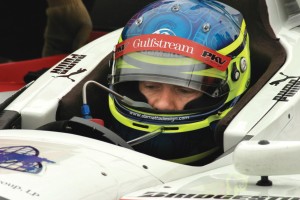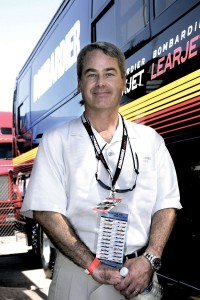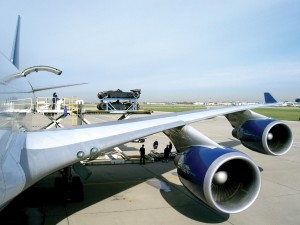By Jeff Mattoon
In many and increasing ways, aviation is utilized in motorsports—from transporting owners to teams to an entire racing series including cars—and for those who love both, it is a powerful quazi-drug that offers intoxicating effects.
To most auto racing fans in America, there is NASCAR and then there is everything else, but that appears to be changing, at least a little. Open wheel racing in the U.S. is experiencing a resurgence with two organizations competing for the race fan’s attention: The Indy Racing League and The Champ Car World Series. To the casual observer, there’s little difference between the two, but to the race fan, the differences are like night and day.
In addition to differences in the cars, like horsepower, design and top speed, the IRL races mostly at oval tracks, but is adding more grand prix-style and street racing courses to its lineup. On the other side of the track, ChampCar races mostly grand prix-style and street courses, but is adding more oval tracks to its lineup. Hmmm, could there be a harmonic convergence on the horizon?
Bombardier likes to race
Speaking of harmony, the marriage of aviation and motorsports—in particular, open wheel racing—appears made in heaven.
“Just over the past five years, where we’ve had significant involvement in IRL, both at the team and the league level, we’ve not only sold many aircraft to team owners and others, but we’ve also noticed a significant increase in brand recognition,” says Scott Westfall, Learjet sales director for Bombardier Aerospace, maker of a whole host of aircraft—from light Lears to heavy, long-range Globals.
Westfall appears enthusiastic when talking about Bombardier’s involvement with motorsports and in particular the IRL. At the Indianapolis Motor Speedway, Bombardier sponsors the control tower pagoda and the company’s logo/name is prominently displayed for races all throughout the year, but in particular during the Indy 500, which, next to the Super Bowl, is the most watched annual event in the world—on television and in attendance. Couple that with all other forms of exposure for a sponsor at that level, and that’s why you witness a whole bunch of people in hospitality suites and tents with smiles on their faces.
Gulfstream competes too!

Cristiano da Matta prepares for the Grand Prix of Denver, supported by a sponsorship from Gulfstream.
Gulfstream is another aircraft manufacturer who recognizes huge benefits in motorsports partnerships.
“Over the years we have found that motorsport racing, whether it’s Formula One, ChampCar or NASCAR, has been a good mix for us, with the types of people we want to reach. It creates an environment that is quite conducive for prospects of ours to see a car race, be entertained by us and see one of our aircraft,” says Robert Baugneit, director of corporate communications at Gulfstream Aerospace.
Branding & B2B
Gulfstream, and for that matter, Bombardier, recognize not only the branding opportunities and hospitality opportunities presented by auto racing, but also the business to business opportunity marketing to other sponsors who they interact with throughout the entire year or years. Bombardier’s Westfall estimates that his company has sold nearly a dozen-and-a-half aircraft that way over the past five years.
“The other side of the equation is that there’s been a longstanding interest between motorcar racing and aviation,” says Baugneit. “Both are terribly interested in aerodynamics—airfoils, airflow over cars, wings on back of cars, keeping the car on the ground—and we are obviously good at airfoils…we understand efficiency and airflow. We’re both worried about safety, speed, high performance products and we both utilize the same elite caliber mechanics.”
It’s such a good fit that Gulfstream and NASCAR are discussing ways to strategically help each other. NASCAR has wind tunnels and Gulfstream, “The Official Business Jet of NASCAR,” has extensive knowledge of aerodynamics and other things precious, and the two could ostensibly share those valuable resources. The aircraft company is interested in fuel economy. The motorsports world has a huge interest in engine technologies and parts reliability, and who better to share what they’ve learned than an aircraft manufacturer who can not rely on pit stops to change out a component gone awry.
In addition to sponsoring a whole race series, Gulfstream also sponsors ChampCar driver Jimmy Vasser’s #12 car, owned by PKV racing. While most team owners who also own aircraft turn right upon entering their jets, Kevin Kalkhoven, the “K” in PKV Racing, makes a left turn and flies himself. Kalkhoven is a type-rated Gulfstream pilot. He’s also type rated in the Citation and Hawker.
“I use my aircraft almost every other day as part of my motorsports activities. We not only travel all over North America, but also to Europe and all over the Pacific,” says Kalkhoven.
Traveling circus
There are 18 cars racing in the ChampCar series. Most of the races occur in North America, but two races, both for the 2005 and the 2006 season, are staged across the Pacific Ocean. Stop and think about it for a moment. How do they get all their stuff over there? It’s complicatedly simple—they fly.
After the race in Las Vegas in September, all the teams ground-transport all the equipment they’ll need for the two races—one in Ansan, South Korea, and one at Surfer’s Paradise, Australia—to Indianapolis, the headquarters for Champ Car World Series. Interestingly, each team signs all those assets over to ChampCar through a power of attorney, and all the equipment, including cars, tires, tools and carts, belongs to ChampCar during the 20,000 mile round-trip racing tour. That’s about $3 million per team worth of gear.
Each race requires about 1,200 tires, so enough tires for South Korea are packed for the first leg of the trip. Additional tires and some other items are placed on a sea cargo ship to meet up with the circuit in Australia, but aside from that, everything else is loaded on two to three chartered 747s.

Specially designed racks allow the Champ Car World Series to take the show on the road all over the world.
What determines whether three versus two 747s are used? Each entrant is allowed two cars with up to 700 pounds of extra cargo, all mounted on a specially designed racking system owned by ChampCar. Additionally, 1,100 pounds of general cargo is allowed per entrant; if they go over their allotment it costs the team $4.65 per pound, on a space-available basis. It’s not unheard of for a team owner to spend upwards of $50,000 for that added equipment.
All of that doesn’t even include the assets that ChampCar owns and must move around, including pace cars, race timing equipment, race car inspection equipment, signage, flags, communications equipment—the list goes on and on.
The rack system is efficient and functional for the racing series, but it’s certainly not standard aircraft cargo equipment.
“I travel to the destination city a day ahead, because although the racking system, which fits into the Boeing system, is user friendly to ChampCar, it’s not to the ground handling personnel in an airport we’ve never been to before,” says Billy Kamphausen, Champ Car World Series’ director of logistics.
It’s early August, two hours before the start of the “Centrix Financial Grand Prix of Denver Presented by PacifiCare.” Kamphausen is carrying two radios and a cell phone and is stopped to answer numerous questions seemingly every two minutes; he’s a busy person with a lot riding on his shoulders.
Team members, consisting of drivers, mechanics, pit crews and managers, and ChampCar officials, consisting of logistics personnel, technical inspectors, public relations personnel and management, travel either commercially or via chartered aircraft; it’s a huge circus of high-tech gear and highly-skilled personnel.
On the horizon for the Champ Car World Series are potential new venues in Japan, China and South Africa, so the logistical experience they’ve acquired in South Korea and Australia will prove a huge resource.
A racer’s racer and a pilot’s pilot
While they certainly comprise the majority, team owners aren’t the only pilots or users of private aircraft. Dario Franchitti, driver of the IRL ArcaEx #27 car for Andretti Green Racing, is a licensed helicopter pilot. He started in a Eurocopter EC120, but has moved over to the faster and more spacious Ecureuil AS350 B3. A resident of Nashville, the Scottish driver likes to fly to races when he can.
“Midwest races, Florida, Watkins Glen, Milwaukee, Kansas—I’ll fly to those. Moving to the B3 has really helped in that regard,” says Franchitti. “Most of the tracks are really helpful. (I use a service) that organizes the airspace and everything. I usually find a place in the infield and leave it there until Sunday night, where I beat the traffic and make my way home.”
In addition to flying the helicopter, the team charters aircraft for a number of races, so Franchitti only has to resort to flying commercially a couple of times a year.
Even though few drivers are pilots, Franchitti believes over time that will change. Currently, the drivers have a huge demand on their schedule during the off season. It’s a time where most would likely obtain their flight training, and as more are exposed to the fun and efficiencies, he thinks they’ll be hooked.
In the perfect world there is a melding of fast or beautiful aircraft, and fast or beautiful cars. If the planes and cars are fast and beautiful—ah, nirvana (now can we get that in pill form?).
For more information on Bombardier, visit [http://www.bombardier.com]; Gulfstream, [http://www.gulfstream.com]; IRL, [http://www.indycar.com]; and ChampCar, [http://www.champcarworldseries.com].

Scott Westfall beams in front of the Bombardier motorcoach at the Honda Indy 225 at Pikes Peak Raceway.













